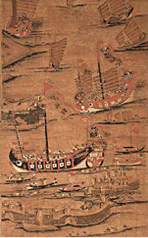CULTURAL TREASURES OF THE RYUKYU KINGDOM : RYUKYUAN
LACQUERWARE
Before 1879 Okinawa Prefecture was an autonomous region
called the Ryukyu Kingdom. It's unique culture began to
take shape in the 15th century upon its unification. Before
unification, Okinawa was separated into three power bases
which paid tribute to China. It remained a tributary Kingdom
well after its unification, and also started to engage in
trade and cultural exchange with Korea, Japan, and numerous
countries in Southeast Asia. The Ryukyus received exceptional
treatment from China. Additionally many aspects of Chinese
civilization, including lacquerware, reached the shores
of the Ryukyu Islands.
|
|
 |
In the 16th century, exceptionally fine lacquerware pieces
were produced in a special facility, the Kaizuri-bugyosho, under
royal administration. This ornate lacquerware smoothed diplomatic
relations with the Ryukyu Kingdom's neighbors. Pieces such as
elaborate black lacquerware with mother-of-pearl inlay were
presented to the shogunates and daimyo (local rulers)on
the mainland, and used as tribute payments to the Chinese Emperor.
The Ryukyuan lacquerware of the time included chinkin,
(detailed carvings with gold inlay), as well as the freer designs
of shu-urushi raden, (cinnabar red lacquer with mother-of-pearl
inlay). Due to local resistance toward various influences from
mainland Japan, raden lacquer in particular continued
to be produced in its uniquely Ryukyuan style even after the
attack by Shimazu of the Satsuma clan in Kyushu in 1609.
By the beginning of the 19th century, production spread to
private workshops. A lot of shu-urushi (cinnabar red)
lacquerware as well as simple designs based on the hakue
(gold leaf aplication) and tsuikin (design overlay) techniques
were made. Hakue and thuikin were especially well
suited for mass production in modern times. |
|
|
|
|
|